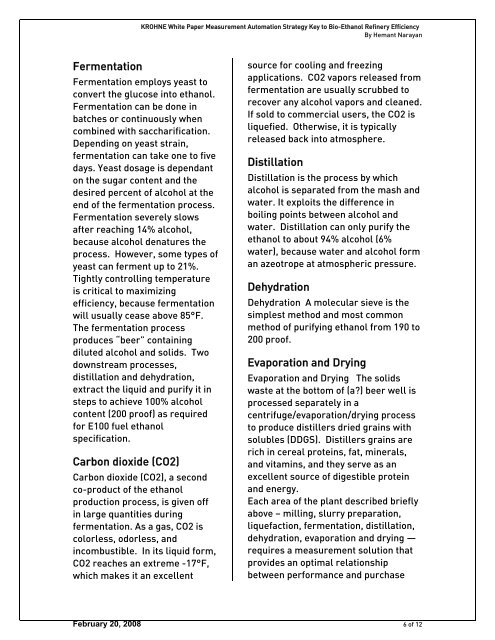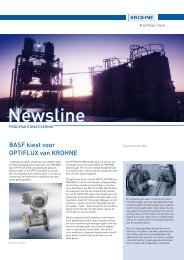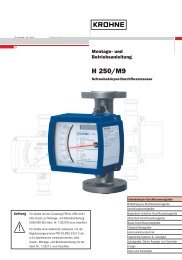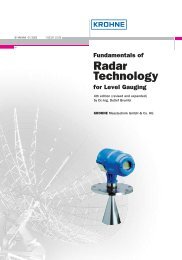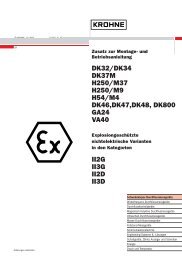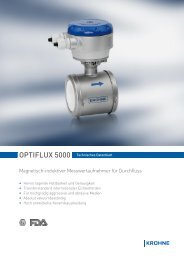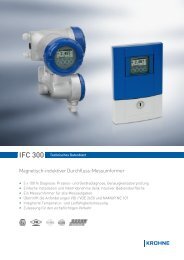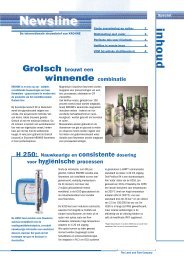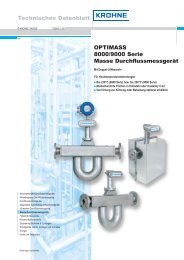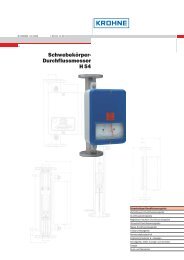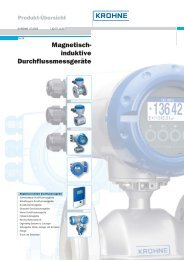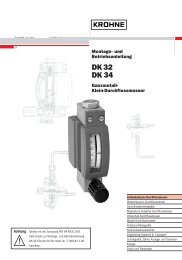Measurement Automation Strategy: Key to Bio-Ethanol ... - Krohne
Measurement Automation Strategy: Key to Bio-Ethanol ... - Krohne
Measurement Automation Strategy: Key to Bio-Ethanol ... - Krohne
Create successful ePaper yourself
Turn your PDF publications into a flip-book with our unique Google optimized e-Paper software.
Fermentation<br />
KROHNE White Paper <strong>Measurement</strong> <strong>Au<strong>to</strong>mation</strong> <strong>Strategy</strong> <strong>Key</strong> <strong>to</strong> <strong>Bio</strong>-<strong>Ethanol</strong> Refinery Efficiency<br />
By Hemant Narayan<br />
Fermentation employs yeast <strong>to</strong><br />
convert the glucose in<strong>to</strong> ethanol.<br />
Fermentation can be done in<br />
batches or continuously when<br />
combined with saccharification.<br />
Depending on yeast strain,<br />
fermentation can take one <strong>to</strong> five<br />
days. Yeast dosage is dependant<br />
on the sugar content and the<br />
desired percent of alcohol at the<br />
end of the fermentation process.<br />
Fermentation severely slows<br />
after reaching 14% alcohol,<br />
because alcohol denatures the<br />
process. However, some types of<br />
yeast can ferment up <strong>to</strong> 21%.<br />
Tightly controlling temperature<br />
is critical <strong>to</strong> maximizing<br />
efficiency, because fermentation<br />
will usually cease above 85°F.<br />
The fermentation process<br />
produces “beer” containing<br />
diluted alcohol and solids. Two<br />
downstream processes,<br />
distillation and dehydration,<br />
extract the liquid and purify it in<br />
steps <strong>to</strong> achieve 100% alcohol<br />
content (200 proof) as required<br />
for E100 fuel ethanol<br />
specification.<br />
Carbon dioxide (CO2)<br />
Carbon dioxide (CO2), a second<br />
co-product of the ethanol<br />
production process, is given off<br />
in large quantities during<br />
fermentation. As a gas, CO2 is<br />
colorless, odorless, and<br />
incombustible. In its liquid form,<br />
CO2 reaches an extreme -17°F,<br />
which makes it an excellent<br />
source for cooling and freezing<br />
applications. CO2 vapors released from<br />
fermentation are usually scrubbed <strong>to</strong><br />
recover any alcohol vapors and cleaned.<br />
If sold <strong>to</strong> commercial users, the CO2 is<br />
liquefied. Otherwise, it is typically<br />
released back in<strong>to</strong> atmosphere.<br />
Distillation<br />
Distillation is the process by which<br />
alcohol is separated from the mash and<br />
water. It exploits the difference in<br />
boiling points between alcohol and<br />
water. Distillation can only purify the<br />
ethanol <strong>to</strong> about 94% alcohol (6%<br />
water), because water and alcohol form<br />
an azeotrope at atmospheric pressure.<br />
Dehydration<br />
Dehydration A molecular sieve is the<br />
simplest method and most common<br />
method of purifying ethanol from 190 <strong>to</strong><br />
200 proof.<br />
Evaporation and Drying<br />
Evaporation and Drying The solids<br />
waste at the bot<strong>to</strong>m of (a?) beer well is<br />
processed separately in a<br />
centrifuge/evaporation/drying process<br />
<strong>to</strong> produce distillers dried grains with<br />
solubles (DDGS). Distillers grains are<br />
rich in cereal proteins, fat, minerals,<br />
and vitamins, and they serve as an<br />
excellent source of digestible protein<br />
and energy.<br />
Each area of the plant described briefly<br />
above – milling, slurry preparation,<br />
liquefaction, fermentation, distillation,<br />
dehydration, evaporation and drying —<br />
requires a measurement solution that<br />
provides an optimal relationship<br />
between performance and purchase<br />
February 20, 2008 6 of 12


